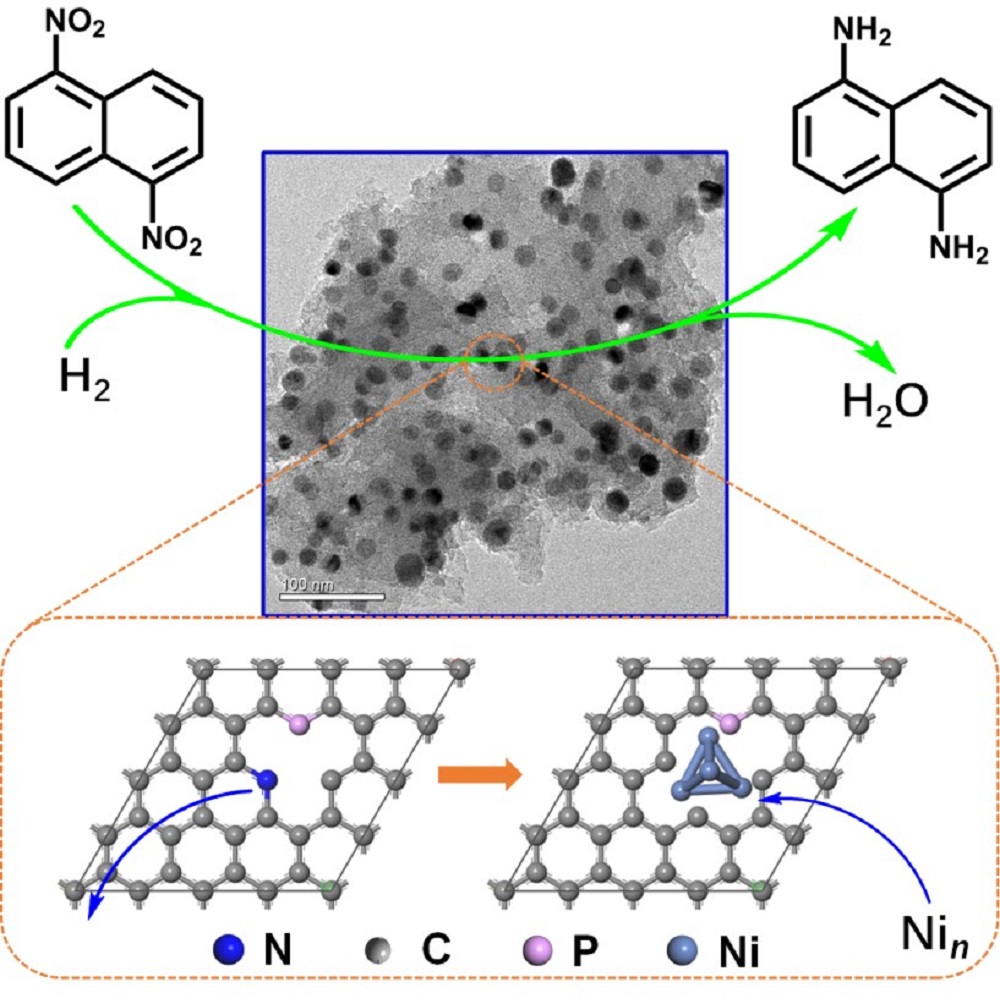1 Introduction
2 Experimental
2.1 Materials
2.2 Catalyst preparation
2.3 Characterizations of catalysts
2.4 Catalytic procedure
2.5 Computational methodology
3 Results and discussions
3.1 N,P-AC supports and Ni/N,P-AC characterization
Tab.1 Nitrogen and phosphorus content and the composition on the N,P-ACs prepared at different temperatures a) |
| Sample | N /At-% | NP /% | NPyr /% | NQ /% | NOx /% | P /At-% | Ph3P /% | Ph3PO /% | (PhO)3PO /% | Phosphate/ phosphoric acid / % | P2O5 /% | High oxidated state P /% |
|---|---|---|---|---|---|---|---|---|---|---|---|---|
| N,P-AC-800 | 1.49 | 34.6 | 26.5 | 20.0 | 18.9 | 1.68 | 11.7 | 24.9 | 24.0 | 18.1 | 21.3 | ‒ |
| N,P-AC-900 | ‒ | ‒ | ‒ | ‒ | ‒ | 1.47 | ‒ | 9.1 | 16.9 | 23.3 | 16.8 | 33.9 |
a) NP: pyridine-N, NPyr: pyrrolic-N, NQ: graphitic-N, NOx: N-oxides |
3.2 Catalytic performance
Tab.2 The catalytic performances of different samples in the liquid-phase hydrogenation of 1,5-dinitronaphthalene a) |
| Catalysts | Time/min | Conv./% | Select./% | ||
|---|---|---|---|---|---|
| 5-Nitro-1-naphthalenamine | 1,5-Diaminonaphthalene | Others | |||
| Ni/AC | 300 | 100 | 82.4 | 16.2 | 1.4 |
| 150 | 86.0 | 94.9 | 4.3 | 0.8 | |
| N,P-AC-900 | 300 | − | − | − | − |
| Ni/N-AC-900 | 300 | 100 | 80.4 | 15.9 | 3.7 |
| Ni/P-AC-900 | 300 | 100 | 35.2 | 61.8 | 3.0 |
| Ni/N,P-AC-800 | 300 | 100 | 38.3 | 59.2 | 2.5 |
| 150 | 99.5 | 88.8 | 9.6 | 1.9 | |
| Ni/N,P-AC-900 | 150 | 100 | − | 95.8 | 4.2 |
| 50 | 96.8 | 91.5 | 7.5 | 1.0 | |
| 5% Pd/C | 50 | 100 | − | 95.9 | 4.1 |
a) Reaction conditions: 1,5-dinitronaphthalene, 2 g; DMF, 20 mL; Catalyst, 0.1 g; Temperature, 100 °C; H2 pressure, 0.6 MPa; Ni loading content, 20%. |
3.3 DFT results
Tab.3 The binding energies of Ni on the different modes of modified carbon supports |
| Ni on different support modes | Total E/eV | Ebind (Ni)/eV |
|---|---|---|
| Original carbon support | ‒74203.2212 | 1.685837824 |
| Graphite-N carbon | ‒74654.7350 | 2.033443912 |
| Pyridine-N carbon | ‒73617.5047 | 5.704832528 |
| Pyrrolic-N carbon | ‒73617.5049 | 5.704233864 |
| Carbon with 12r-defect | ‒73164.0703 | 6.603644888 |
| Carbon with 14r-defect | ‒72127.2686 | 6.872472236 |
| 2Ni on Carbon with 14r-defect | ‒113168.2959 | 5.025827819 |
| 3Ni on Carbon with 14r-defect | ‒154208.7550 | 4.220880532 |
| 4Ni on Carbon with 14r-defect | ‒195250.2349 | 4.073607147 |
| 5Ni on Carbon with 14r-defect | ‒236291.2345 | 3.889190199 |
| 6Ni on Carbon with 14r-defect | ‒277307.2994 | ‒0.389540234 |
Tab.4 The adsorption energies of H2 on Ni loaded on the different carbon supports |
| Different modes | Total E/eV | Eads (H2)/eV |
|---|---|---|
| H2 | ‒31.57349582 | − |
| Ni on carbon support without P doping (1) | ‒72127.20158 | − |
| Ni on carbon support with P doping (2) | ‒81413.59703 | − |
| H2 adsorption on (1) | ‒72159.25703 | 0.48195717 |
| H2 adsorption on (2) | ‒81445.92856 | 0.75803652 |






